|
|
|
Sort Order |
|
|
|
Items / Page
|
|
|
|
|
|
|
| Srl | Item |
| 1 |
ID:
122084
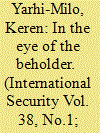

|
|
|
|
|
| Publication |
2013.
|
| Summary/Abstract |
How do policymakers infer the long-term political intentions of their states' adversaries? A new approach to answering this question, the "selective attention thesis," posits that individual perceptual biases and organizational interests and practices influence which types of indicators a state's political leaders and its intelligence community regard as credible signals of an adversary's intentions. Policymakers often base their interpretations on their own theories, expectations, and needs, sometimes ignoring costly signals and paying more attention to information that, though less costly, is more vivid (i.e., personalized and emotionally involving). In contrast, intelligence organizations typically prioritize the collection and analysis of data on the adversary's military inventory. Over time, these organizations develop substantial knowledge on these material indicators that they then use to make predictions about an adversary's intentions. An examination of three cases based on 30,000 archival documents and intelligence reports shows strong support for the selective attention thesis and mixed support for two other approaches in international relations theory aimed at understanding how observers are likely to infer adversaries' political intentions: the behavior thesis and the capabilities thesis. The three cases are assessments by President Jimmy Carter and officials in his administration of Soviet intentions during the collapse of détente; assessments by President Ronald Reagan and administration officials of Soviet intentions during the end of the Cold War; and British assessments of Nazi Germany before World War II.
|
|
|
|
|
|
|
|
|
|
|
|
|
|
|
|
| 2 |
ID:
122089


|
|
|
| 3 |
ID:
122085
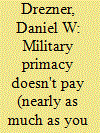

|
|
|
|
|
| Publication |
2013.
|
| Summary/Abstract |
Acommon argument among scholars and policymakers is that America's military preeminence and deep international engagement yield significant economic benefits to the United States and the rest of the world. Ostensibly, military primacy, beyond reducing security tensions, also encourages economic returns through a variety of loosely articulated causal mechanisms. A deeper analytical look reveals the causal pathways through which military primacy is most likely to yield economic returns: geoeconomic favoritism, whereby the military hegemon attracts private capital in return for providing the greatest security and safety to investors; direct geopolitical favoritism, according to which sovereign states, in return for living under the security umbrella of the military superpower, voluntarily transfer resources to help subsidize the costs of hegemony; and the public goods benefits that flow from hegemonic stability. A closer investigation of these causal mechanisms reveals little evidence that military primacy attracts private capital. The evidence for geopolitical favoritism seems more robust during periods of bipolarity than unipolarity. The evidence for public goods benefits is strongest, but military predominance plays only a supporting role in that logic. While further research is needed, the aggregate evidence suggests that the economic benefits of military hegemony have been exaggerated in policy circles. These findings have significant implications for theoretical debates about the fungibility of military power and should be considered when assessing U.S. fiscal options and grand strategy for the next decade.
|
|
|
|
|
|
|
|
|
|
|
|
|
|
|
|
| 4 |
ID:
122087
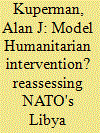

|
|
|
|
|
| Publication |
2013.
|
| Summary/Abstract |
NATO's 2011 humanitarian military intervention in Libya has been hailed as a model for implementing the emerging norm of the responsibility to protect (R2P), on grounds that it prevented an impending bloodbath in Benghazi and facilitated the ouster of Libya's oppressive ruler, Muammar al-Qaddafi, who had targeted peaceful civilian protesters. Before the international community embraces such conclusions, however, a more rigorous assessment of the net humanitarian impact of NATO intervention in Libya is warranted. The conventional narrative is flawed in its portrayal of both the nature of the violence in Libya prior to the intervention and NATO's eventual objective of regime change. An examination of the course of violence in Libya before and after NATO's action shows that the intervention backfired. The intervention extended the war's duration about sixfold; increased its death toll approximately seven to ten times; and exacerbated human rights abuses, humanitarian suffering, Islamic radicalism, and weapons proliferation in Libya and its neighbors. If it is a "model intervention," as senior NATO officials claim, it is a model of failure. Implementation of R2P must be reformed to address these unintended negative consequences and the dynamics underlying them. Only then will R2P be able to achieve its noble objectives.
|
|
|
|
|
|
|
|
|
|
|
|
|
|
|
|
| 5 |
ID:
122090


|
|
|
| 6 |
ID:
122088
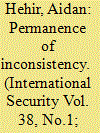

|
|
|
|
|
| Publication |
2013.
|
| Summary/Abstract |
Many observers heralded the Security Council-sanctioned intervention in Libya in March 2011 as evidence of the efficacy of the responsibility to protect (R2P). Although there is no doubt that the intervention was significant, the implications of Resolution 1973 are not as profound as some have claimed. The intervention certainly coheres with the spirit of R2P, but it is possible to situate it in the context of a trajectory of Security Council responses to large-scale intrastate crises that predate the emergence of R2P. This trajectory is a function of the decisionmaking of the five permanent members of the Security Council (P5), a group guided by politics and pragmatism rather than principles. As a consequence, the Security Council's record in dealing with intrastate crises is characterized by a preponderance of inertia punctuated by aberrant flashes of resolve and timely action impelled by the occasional coincidence of interests and humanitarian need, rather than an adherence to either law or norms. The underlying factors that contributed to this record of inconsistency-primarily the P5's veto power-remain post-Libya, and thus the international response to intrastate crises likely will continue to be inconsistent.
|
|
|
|
|
|
|
|
|
|
|
|
|
|
|
|
| 7 |
ID:
122086
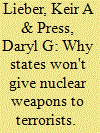

|
|
|
|
|
| Publication |
2013.
|
| Summary/Abstract |
Many experts consider nuclear terrorism the single greatest threat to U.S. security. The fear that a state might transfer nuclear materials to terrorists was a core justification for the invasion of Iraq in 2003 and, more recently, for a strike against Iran's nuclear program. The logical basis for this concern is sound: if a state could orchestrate an anonymous nuclear terror attack, it could destroy an enemy yet avoid retaliation. But how likely is it that the perpetrators of nuclear terrorism could remain anonymous? Data culled from a decade of terrorist incidents reveal that attribution is very likely after high-casualty terror attacks. Attribution rates are even higher for attacks on the U.S. homeland or the territory of a major U.S. ally-97 percent for incidents in which ten or more people were killed. Moreover, tracing a terrorist group that used a nuclear weapon to its state sponsor would not be difficult, because few countries sponsor terror; few terror groups have multiple sponsors; and only one country that sponsors terrorism, Pakistan, has nuclear weapons or enough material to manufacture them. If leaders understand these facts, they will be as reluctant to give weapons to terrorists as they are to use them directly; both actions would invite devastating retaliation.
|
|
|
|
|
|
|
|
|
|
|
|
|
|
|
|
|
|
|
|
|